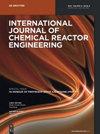黑曲霉(Aspergillus niger var tubingesis Ed8)对芳香族有机化合物的降解产生减少Cr(VI)的代谢产物
IF 1.4
4区 工程技术
Q3 Chemical Engineering
International Journal of Chemical Reactor Engineering
Pub Date : 2022-11-15
DOI:10.1515/ijcre-2022-0074
引用次数: 0
摘要
摘要铬(VI)是一种对任何生物都具有高度毒性的环境污染物,其在环境中的存在主要是由于人类活动。生物技术已被用于处理被Cr(VI)污染的废水。我们的工作组已从培养基中分离出几种能够去除Cr(Ⅵ)的真菌和细菌。黑曲霉(Aspergillus niger var tubingesis Ed8)是一种能够产生将Cr(VI)还原为Cr(III)的代谢产物的菌株。这项工作的目的是确定水杨酸钠对该菌株生长和Cr(VI)还原系统的影响,并鉴定水杨酸钠产生的代谢产物。我们的结果表明,与对照条件(0mM)相比,含有水杨酸钠(20mM)的培养基抑制菌株生长。然而,它使Cr(VI)红/mg生物质的比还原能力增加了一个数量级。对应于培养48小时的培养基的分析显示邻苯二酚和水杨酸盐减少的存在。此外,作为无细胞细胞提取物的酶活性的产物,在孵育24小时后,检测水杨酸盐的消耗,以及存在对应于间苯二酚和邻苯二酚的峰。我们的结果表明,根据培养基的组成,可以提高Ed8菌株的Cr(VI)还原能力。本文章由计算机程序翻译,如有差异,请以英文原文为准。
The degradation of an aromatic organic compound by Aspergillus niger var tubingensis Ed8 produces metabolites that reduce Cr (VI)
Abstract Chromium Cr(VI) is a highly toxic environmental contaminant for any organism, its presence in the environment is mainly due to anthropogenic activities. The use of biotechnology has been implemented for the treatment of effluents contaminated with Cr(VI).Our working group has isolated several fungi and bacteria capable of removing Cr(VI) from the culture medium. Aspergillus niger var tubingensis Ed8 is a strain that can produce metabolites which reduce Cr (VI) to Cr (III). The objective of this work was to determine the effect of sodium salicylate on the growth of this strain and on the Cr(VI) reduction system, as well as to identify the metabolites that are produced from sodium salicylate. Our results show that the Culture medium containing sodium salicylate (20 mM) inhibits strain growth compared to the control condition (0 mM). However, it increases the specific reduction capacity of Cr (VI) red/mg Biomass in order of magnitude. Analysis of the culture medium corresponding to 48 h of incubation shows the presence of catechol and salicylate diminution. In addition, as a product of the enzymatic activity of a cell-free cellular extract, after 24 h of incubation, the consumption of salicylate is detected, as well as the presence of peaks corresponding to resorcinol and catechol. Our results show that it is possible to increase the Cr(VI) reducing capacity of the Ed8 strain, depending on the composition of the culture medium.
求助全文
通过发布文献求助,成功后即可免费获取论文全文。
去求助
来源期刊
CiteScore
2.80
自引率
12.50%
发文量
107
审稿时长
3 months
期刊介绍:
The International Journal of Chemical Reactor Engineering covers the broad fields of theoretical and applied reactor engineering. The IJCRE covers topics drawn from the substantial areas of overlap between catalysis, reaction and reactor engineering. The journal is presently edited by Hugo de Lasa and Charles Xu, counting with an impressive list of Editorial Board leading specialists in chemical reactor engineering. Authors include notable international professors and R&D industry leaders.

 求助内容:
求助内容: 应助结果提醒方式:
应助结果提醒方式:


